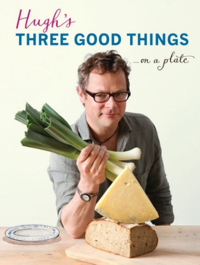Hugh’s Three Good Things …on a Plate (Bloomsbury 2015) from Hugh Fearnley-Whittingstall captures the way we cook and want to cook. He calls it ridiculously simple (p. 7). Its pages are filled with photographs by Simon Wheeler of straightforward and yet richly thoughtful dishes that speak volumes about not ruining three good things.
There are also great illustrations by Mariko Jesse.
Hugh has fun with his Trinity, and yet he never takes it too far:
Your recipes, my recipes –hey, our recipes – are all going to be based on the idea of three complementary elements in which the whole plate becomes greater than the sum of its parts. But that doesn’t mean that the recipes always have only three ingredients. Far from it. Many of these dishes have a dressing, a knob of butter, a dash of oil or a sprinkling of spice to help them along. (p. 9)
 The point is that three ingredients really do work together – and, he points out, in many recipes you could take away practically all the other ingredients and those three remaining ones carry the dish. He encourages swaps – so celery for fennel, plums for peaches, etc. This one compilation of great trios will yield plenty more recipes as long as you understand what makes each recipe work.
The point is that three ingredients really do work together – and, he points out, in many recipes you could take away practically all the other ingredients and those three remaining ones carry the dish. He encourages swaps – so celery for fennel, plums for peaches, etc. This one compilation of great trios will yield plenty more recipes as long as you understand what makes each recipe work.
Hugh starts with a lesson on salads. He breaks down how to think about three ingredients: a substantial ingredient (pulses, protein, or a roast root vegetable, a tangy or zesty ingredient like raw fruit, and a crunchy or aromatic vegetable like fennel, or salad leaves. You add a dressing (olive oil, vinegar or lemon juice, and salt and pepper) and you are set. First trio is Courgettes, Mangetout, Lemon (p. 14) – or in American-speak Zucchini, Sugar Snap Peas (or Snow Peas), Lemon. “The crisp, sweet crunch of mangetout, and vegetal bite of baby courgettes go incredibly well with the tang of citrus fruit in this lovely summer starter salad.” The suggested swap is for orange. There is also mint and dill in the recipes along with olive oil and lemon. The next salad is Tomatoes, Chilli, Parsley (p. 17). It’s a salad to make in August when you have a bumper crop of cherry and large tomatoes. The only added ingredients are olive oil, cider vinegar, and salt and pepper. Make the Fennel, Orange, Watercress (p. 18) salad now before tomato season. “Sweet sharp orange flesh and crunchy, aniseedy fennel are a great match, and the pepperiness of watercress really brings the dish alive.” The point is to find that balance between the different flavors and textures – limiting the number of main ingredients makes the thought process behind the salad easy to understand.
The same thinking applies to the Appetizer chapter. Take the Asparagus, Yogurt, Dukka (p. 59) recipe. Master the Dukka and you have a great way to serve any grilled vegetable this summer. Use the same asparagus in the next recipe, Asparagus, Egg, Ham (p. 60) a dish of poached eggs, asparagus and Parma ham served with a lovely chunk of bread. It’s an incredibly simple, yet elegant dish. But what if you are in the midst of asparagus season, then try the Pasta, Asparagus, Chorizo (p. 288) that works well with plenty of other green vegetables like broad beans, peas, or green beans. It’s the kind of dish that you can actually see the three colors, the matching shapes of red, green, and white, and the rich sauce provided by the chorizo.
This is a rich book worth exploring and worth having fun with. It’s a book for a new cook – your graduating seniors – to help them actually think about what makes for a good dish, how ingredients go together, without becoming over complicated. It’s also fun for the experienced cook – Mom? – who needs a little help thinking of how to vary the tried and true recipes in their repertoire. It’s simply ridiculously a great gift.

